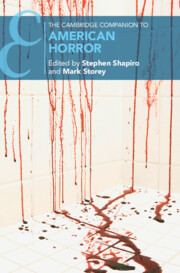Book contents
- The Cambridge Companion to American Horror
- The Cambridge Companion to American Horror
- Copyright page
- Contents
- Acknowledgments
- Contributors
- Introduction
- Part I Histories
- Part II Genres
- 7 Body Horror
- 8 Queer Horror
- 9 Folk Horror
- 10 Occult Horror
- 11 SF and the Weird
- 12 Monsters and Monstrosity
- Index
- Cambridge Companions To …
- References
8 - Queer Horror
from Part II - Genres
Published online by Cambridge University Press: 21 July 2022
- The Cambridge Companion to American Horror
- The Cambridge Companion to American Horror
- Copyright page
- Contents
- Acknowledgments
- Contributors
- Introduction
- Part I Histories
- Part II Genres
- 7 Body Horror
- 8 Queer Horror
- 9 Folk Horror
- 10 Occult Horror
- 11 SF and the Weird
- 12 Monsters and Monstrosity
- Index
- Cambridge Companions To …
- References
Summary
This chapter examines the queer Gothicism of American horror to consider the ways in which marginalized genders and sexualities have been either condemned or covertly endorsed through horror’s textual and visual mediums. In mainstream cis-heteronormative society, queer genders and sexualities have been an abjectified, “horrific” presence, and these mainstream investments represented via horror, as a mode of expression devoted to irruptions of the body, means that the presence of queerness is often registered as an a priori spoliation of bodily norms. Like the term “queer” itself, audiences have often reappropriated the Gothic figures that appear in horror, and some queer creators have intentionally deployed such Gothicisms for the sake of representing queerness. This chapter explores the conflicting purposes of horror’s depiction of queerness by reviewing several Gothic tropes as they appear in American horror texts, focusing specifically on monstrosity, vampirism, the asylum, medical body horror, and haunting.
- Type
- Chapter
- Information
- The Cambridge Companion to American Horror , pp. 120 - 138Publisher: Cambridge University PressPrint publication year: 2022



